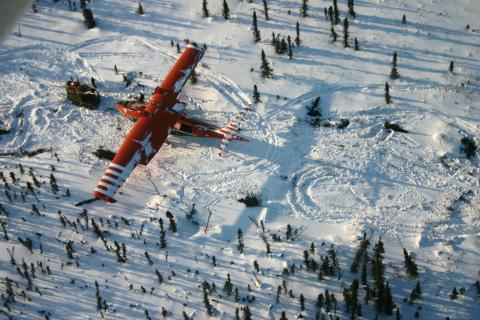October 2008 - NTCL Barges The Canso from Inuvik to Hay River - about 1000 km on the MacKenzie River, then on to Fairview, AB with help from Capstan Hauling and many others
by Doug Roy on 05/03/10
SALVAGING HISTORY
By Keith Gerein, Calgary Herald
For the next stage of the journey, the plan was to turn south. The Canso was to be hooked up to a truck that would carefully transport it along 2,500 kilometres of highway to Fairview.
But another business owner from Inuvik -- a man who provided a free satellite phone to Wieben -- had a better idea. He suggested the plane instead be dragged north through Inuvik to the shipyards of the Northern Transportation Company Ltd.
The man said a friend of his with the transport company would put the plane on a Mackenzie River barge. The barge would drop it off in Hay River, N.W.T., near the Alberta border, saving Wieben's crew days of aggravation on the highway.
Agreeing to this new proposal, the group still had one obstacle to overcome. The trip to the shipyard was via a road that appeared too narrow to handle the aircraft.
The Canso's wingspan was originally 32 metres, but about three metres of the right side had broken off in the 2001 crash. Wieben's crew decided to cut off another three metres that had to be replaced anyway, which shortened the width just enough to get it down the road.
"We made it with about two feet of space to spare between the power poles," Wieben says.
As promised by the barge company, the Canso showed up in Hay River a few months later, in October.
But to tow the plane back to Fairview, Wieben again needed a favour. This time, a trucking company from Grande Prairie came to his aid by loaning him a special double-drop trailer -- a device that ensured the 19-metre-long plane rode low enough to travel underneath highway overpasses.
"We were basically strangers out of the blue, but the co-operation we got from people throughout the trip was just amazing," Wieben says.
After removing the top wing and loading it onto a separate trailer, the two sections of the aircraft were driven south to a welcome in Fairview, where it was put on display last summer for six weeks.
Despite all the work that went into rescuing the plane, Wieben says that was just Phase 1 of a three-part process. The second phase will be to determine if the plane can be restored to flying condition. If so, the plan is to operate it as a heritage airplane and fly it to various air shows around the country. Roy also hopes to take it to small northern communities for short visits, allowing children to learn a little about Canadian aviation history.
So far, the repair process has been daunting. Canso parts are hard to find and expensive, and the group will have to pay for certified engineers to do some of the work. Wieben believes it may cost up to $300,000 to get the plane airborne.
He hopes people will come forward with donations of money, parts or aircraft expertise. The group is also considering selling shares in the plane or applying for heritage and educational grants from the government.
Should the repair process fall short, Wieben says the plane will likely be turned into a static display that people can visit.
"All of us in the group can put some money into it, but none of us are wealthy," he said of the six members of the "Canso Crew," all of whom are in their 60s except for Luken. "We've got it this far, but there's a chance for so much more."
"Whenever I turn on the TV news at night, all I hear is the negative -- a killing in Afghanistan, a murder in Vancouver," Wieben says.
"But the experience of Canada we had being involved with this Canso is so much different. We met so many great people that helped us achieve our goal.
"And this is just a little story. Six farmers bring a derelict airplane out of the North. And yet it was such a great adventure."
Read more: http://www.calgaryherald.com/SALVAGING+HISTORY/2593025/story.html#ixzz0mvkdJHXK
